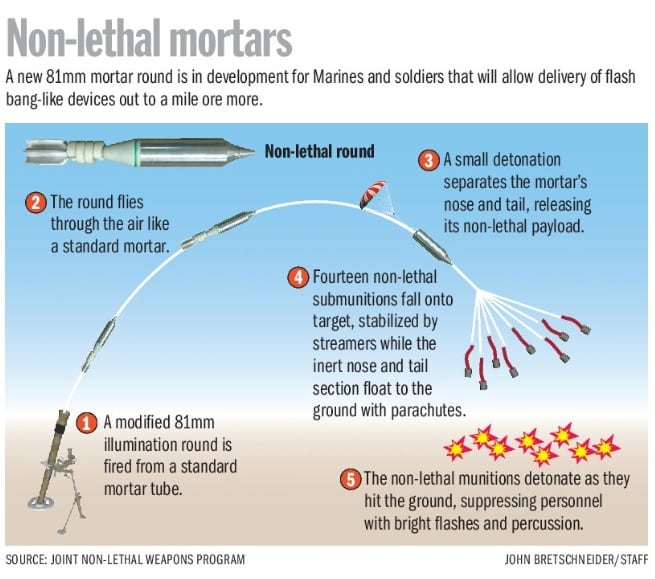ABERDEEN PROVING GROUND, Md. — A new 81mm mortar can deliver a terrifying barrage of flash bangs to distances beyond a mile while minimizing collateral damage.
Developers from all military branches working with the Quantico, Virginia-based Joint Non-Lethal Weapons Directorate fired the non-lethal mortar 15 times here Dec. 3 as part of its first working demonstration.
They dropped the cartridge by hand into a standard mortar tube. It disappeared into low cloud cover with an earth-shaking bang. As it soared toward the target it broke open releasing 14 sub-munitions on a time-delay fuse. As the tail and nose sections of the mortar gently floated toward earth on parachutes, the cardboard-encased rounds detonated on the ground with a terrifying series of flashes and thunderous bangs — impressive even from nearly a mile away.

A test version of a non-lethal mortar was fired Dec. 3. (Source: Joint Non-lethal Weapons Program)
Photo Credit: John Bretschneider/Staff
It was the equivalent of delivering 14 M84 stun grenades over an 80 by 50 foot area. Like a flash bang, the munitions are meant to temporarily daze people through their intensely loud sound and bright light. That is putting it kindly, however, said Ray Grundy, who leads the mortar's development and serves as the Escalation of Force Branch head at Marine Corps Combat Development and Integration Command.
"If that stuff is dropping on you, you are going to go to ground or run," he said.
That's the idea. To either interfere with enemies' ability to fire on Marines, deny them an area, or move people in a desired direction.
"If your mission is to assault across terrain and take an enemy stronghold, but insurgents are embedded with non-combatants, you are going to subject your forces to enemy observation and fields of fire," said Grundy, a retired Chief Warrant Officer 5 and Marine gunner.
This provides a new option to suppress the enemy, save Marines and spare civilians, he said.
The round proved it can reliably hit targets between about 500 and 1,600 yards, the project's minimum objective, but could reach about a mile and a half or more, according to developers.
Based on the modified body of a standard M853A1 81mm illumination round, the munition is compatible with existing mortar tubes.
The ability to suppress or redirect enemy forces without hurting innocents becomes increasingly important in a counterinsurgency environment.
Non-lethal options are especially important following the Marine Corps' rollout of Expeditionary Force 21 — a concept of operations meant to meet conditions on a battlefield that will be increasingly unpredictable, unconventional and in close proximity to civilian populations.
"EF-21 talks about those situations as being more prevalent in the years to come," Grundy said.
Now that the round has proven viable, developers intend to push forward in fiscal 2015 with efforts to present the program to Marine Corps Systems Command in Quantico. His team will create a capabilities document and eventually seek a Defense Department Identification Code for the mortar, which would secure its status as a standard, regularly stocked munition that infantry battalions would carry into combat.
Grundy was inspired to pursue a non-lethal mortar after a visit with 3rd Battalion, 5th Marines, at Camp Pendleton, California, in the summer of 2008, shortly after the unit returned from a deployment to Iraq. The unit's Marines described the harassing fires they took. Rogue mortarmen would lob rounds toward their forward operating base from civilian populated areas, the executive officer said.
"Three-five had restrictive firing rules so they couldn't respond in kind because of the risk of non-combatant casualties," Grundy said.
An earlier Army initiative identified a capabilities gap that meant units had no way of delivering non-lethal force over long distances and had worked to develop a way to deliver non-lethals via mortar munitions. A round was developed in 2003 without a payload. The program, which had been around since at least 2003, had developed a round, but without a payload. In 2009, Grundy seized on that idea and revitalized the effort, discussing the idea with officials at to the Air Force Human Effects Center of Excellence.
Developing the new munition was a a joint effort with close cooperation between officials from all the services. By using the earlier study and mostly existing mortar components and partnering with multiple services, Grundy's team was able to create a working round in just about three years.
"We were well on our way to incorporating it with our current payload, so we can add it to the capability you see here today," said Grundy said.




